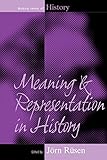Meaning and Representation in History / ed. by Jörn Rüsen.
Material type: TextSeries: Making Sense of History ; 7Publisher: New York ; Oxford : Berghahn Books, [2006]Copyright date: ©2006Description: 1 online resource (292 p.)Content type:
TextSeries: Making Sense of History ; 7Publisher: New York ; Oxford : Berghahn Books, [2006]Copyright date: ©2006Description: 1 online resource (292 p.)Content type: - 9781845452629
- 9780857455550
- 901 23
- online - DeGruyter
| Item type | Current library | Call number | URL | Status | Notes | Barcode | |
|---|---|---|---|---|---|---|---|
 eBook
eBook
|
Biblioteca "Angelicum" Pont. Univ. S.Tommaso d'Aquino Nuvola online | online - DeGruyter (Browse shelf(Opens below)) | Online access | Not for loan (Accesso limitato) | Accesso per gli utenti autorizzati / Access for authorized users | (dgr)9780857455550 |
Frontmatter -- Contents -- List of Illustrations -- Preface to the Series -- Introduction: What does “Making sense of history” mean? -- Part I: Meaning -- Chapter 1: Memory—Forgetting—History -- Chapter 2: How Meaning Came into the World and What Became of It -- Chapter 3: Sense of History: What does it mean? -- Chapter 4: “The Meaning of History” A Modern Construction and Notion? -- Chapter 5: The Meanings of History -- Chapter 6: The Three Levels of “Sinnbildung” in Historical Writing -- Chapter 7: The Reality of History -- Chapter 8: Language and Historical Experience -- Part II: Representation -- Chapter 9: Flights from History -- Chapter 10: Memory and Identity -- Chapter 11: The Material Presence of the Past -- Chapter 12: Ruins: A Visual Expression of Historical Meaning -- Chapter 13: Three Versions of Wallenstein -- Chapter 14: The Arts of Jewish Memory in a Postmodern Age -- Bibliography -- Notes on the Contributors -- Index of Names
restricted access online access with authorization star
http://purl.org/coar/access_right/c_16ec
History has always been more than just the past. It involves a relationship between past and present, perceived, on the one hand, as a temporal chain of events and, on the other, symbolically as an interpretation that gives meaning to these events through varying cultural orientations, charging it with norms and values, hopes and fears. And it is memory that links the present to the past and therefore has to be seen as the most fundamental procedure of the human mind that constitutes history: memory and historical thinking are the door of the human mind to experience. At the same time, it transforms the past into a meaningful and sense bearing part of the present and beyond. It is these complex interrelationships that are the focus of the contributors to this volume, among them such distinguished scholars as Paul Ricoeur, Johan Galtung, Eberhard Lämmert, and James E. Young. Full of profound insights into human society pat and present it is a book that not only historians but also philosophers and social scientists should engage with.
Mode of access: Internet via World Wide Web.
In English.
Description based on online resource; title from PDF title page (publisher's Web site, viewed 25. Jun 2024)


